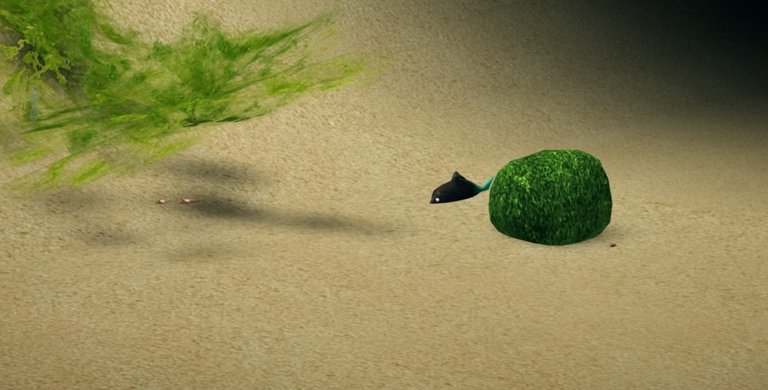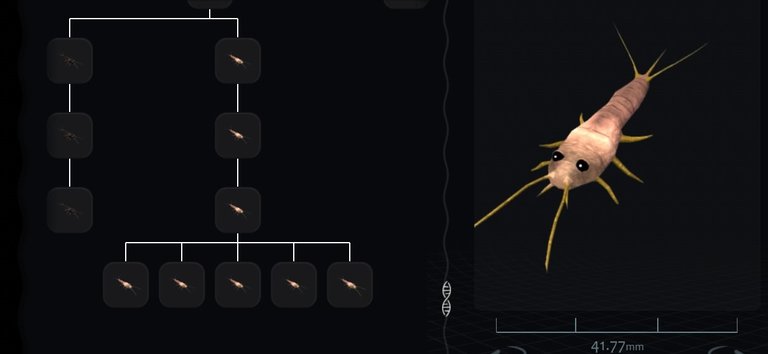
Welcome to the world of Creatura! You are a scientist and are in charge of cultivating life in a small tank! Technically, my simulated ecosystem is just an aquarium at the moment, even though it has some land animals that adapted to survive here. Later, once the inhabitants are a bit more varied, I will make the water level drop while also increasing the elevation in a few peaks. I am in control of everything from ph of the water, temperature, even natural selection.
Each rock is a home for a community of animals. They eventually get covered in algae, which I let run wild. So far, the animals which we will study in this enclosure feed on simpler, lower vegetation concentrated in the far left and center of the habitat. To the right are experimental prototypes of trees and branching plants I have developed through various forms of mutation breeding.

The tank started with only a few random plants and some sea sponges. Eventually, flatworms like this one emerged, still retaining the original pigment of the mother sponge. One of the simplest ways to encourage an organism down a particular evolutionary path is to control its diet. In order for the first fish to evolve, the flatworms need to feed on tall plants with simple leaf structure. This was challenging as I started with tall complex plants so, evolutionarily, it seemed I had to work backwards towards simple leaves. Evolution does not work in any direction however, only in response to stimuli. What I ended up doing what monitoring my tall plants for random mutations in leaf structure whose markers I was then able to isolate in its genome. Fine. I'll do it myself.
The hardest part was the waiting. Along the way, I encountered many other mutations and marked the codons such as leaf size and color along with a few other specific phenotypes.

Finally, bony fish emerged.
The fish display a wide array of behaviors.

A young fish was spotted curiously investigating the homes of some other vertebrates and invertebrates.

Here a group of adults spawns in the sands near my prized flowering nightshade.

This self burying behavior I have observed is still a mystery to me. Maybe the fish is stalking something. There is a tiny creature (most likely a slug) along with a pair of silverfish. Want a closer look? Ok, let me whip out my macro lens.

I absolutely adore these little guys! They are herbivores, live up to 4 years, and are evolutionarily older than the dinosaurs. They reproduce rather slowly though, so natural mutations are few and far between.

Here is a snippet of my genetically engineered tree of life. As you can see, there was a bloodline going of a black colored species of silverfish. After I modified an individual to produce lighter colored pigments in its head, legs, body, and tail a cascade of events must have happened. It is possible, and my intention, that the lighter pigment might make their predation more difficult and thus survive. What I did not expect is for the new species to overall outcompete the original, leading to its eventual demise.
Where did this advanced lifeform come from?

The silverfish's evolutionary predecessor was this lowly shrimp, photo captured here in the lab just as it was waking up. See the resemblance? It was this organism that taught me which codons to mark for different types of pigment production.

And here are that shrimp's descendants today in their natural albeit simulated habitat, feeding on some complex leaves. Their bright red color makes them look very inviting to larger animals, namely fish.

Nearby, a small heavily armored snail makes its way downtown. It is a perfect example of what happens to a vulnerable species that is not babied.

Their bright red slug ancestors found a way to adapt to this harsh, ever changing environment, all on their own. It just took forever.

Some of them weren't so smart. Here's a pair of them at the site where I applied (a little too much of) a mild carcinogen. It has a sweet, honey crisp apple flavor so that the animals don't complain that the poison tastes bad. They went to town on the stuff. The experiment was a success, but the subjects died.
The only organism I excluded from the photoshoot was this family of animals, something of a missing link between my flatworms and the horseshoe crab. They are not ready. They keep migrating towards the complex plant forests. I relocate them closest to the algae and lichens so that they may adapt to that diet and future generations might become true horseshoe crabs. Until then, fish will remain evolutionarily stagnant. The emergence of a more nutritious and armored animal like the horseshoe crab will stimulate the fish to further its own arms race and will lead to higher lifeforms.
Maybe in the future this ecosystem will be more complete with distinct biomes and more varied species. That's the goal at least: one big interconnected food web of wild plants and animals all living peacefully, in a tank.
This post is an entry for the Gaming Photography Weekly Contest: Wildlife